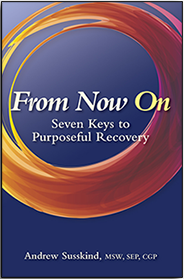When I went to graduate school at UCLA in the early ‘90s, there was no mention of the nervous system in any of my classes. The mind-body-spirit connection may have been a brief footnote, but all I learned about the nervous system was the fight-or-flight response, a survival instinct mentioned in my undergraduate psychology classes. Three decades later, most curriculums not only include the brain research as it pertains to the nervous system, but also emphasize its tremendous healing potential.
While addictive, compulsive behaviors can help you feel better, the relief is short-lived, as the suffering always returns. Compulsive sexual behavior hijacks your brain, resulting in chronic nervous system dysregulation, perpetuating the turmoil inside you. In its simplest terms, dysregulation is a disruption of your autonomic nervous system—an up-regulation that can cause panic attacks or rage, or a down-regulation that may lead to dissociation or disconnection. Either way, there’s an imbalance, leaving you with one of the greatest challenges in recovery—building the capacity for whatever life throws at you.
Regulation and Dysregulation. Dr. Peter Levine, founder of Somatic Experiencing and author of Waking the Tiger, believes that it’s essential to restore the wisdom of the nervous system through trauma healing. The brain-body connection is your internal temperature gauge, letting you know when you need to adjust the thermostat to return to resilience and resourcefulness. In general, you’re more likely to relapse when dysregulated and to stay sober when regulated.
One simple strategy to move from dysregulation to regulation is through resourcing: recalling memories of love and nurturing to calm your nervous system. For instance, if you have a memory of playing with your dog in the park on a beautiful spring day, reimagining that scene will help you regulate. With practice, resourcing can become a touchstone of your nervous system health and leave you less vulnerable to using sex as a mood regulator.
Other “brain-body therapies” that help regulate the nervous system include Somatic Experiencing, Brainspotting and the Trauma Resource Model, which involve tracking your physiological sensations, grounding yourself in your body, and reorienting toward a balanced nervous system without the use of compulsive sex.
We’ve long known that “the body remembers”, trauma gets shelved in the subcortex of the brain, a storage place for highly unpleasant memories and experiences that were too much to process at the time. Stored trauma may come out in ways that are clear, such as rage and terror, and ways that are subtle, like vague sadness, irritability, or shutting down. When you understand more about the brain-body connection, you’re more equipped to handle compulsive cravings, and as a result see that relief is within reach.
So what exactly does the nervous system have to do with sexual compulsion? Our bodies have instinctive functions, like breathing, blood circulation, digestion, elimination, and sexual arousal. These are managed by our nervous system that is divided into two parts—the sympathetic and parasympathetic branches; the sympathetic branch lets you know when to fight, flee, or freeze, and the parasympathetic system focuses on resting and digesting. When the nervous system becomes over-activated or under-activated, all of your basic functions are impacted, leaving you challenged to return to equilibrium.
For example, your daughter’s teacher calls to let you know she’s crying uncontrollably from being bullied on the playground and wants to go home. Immediately, your heart rate increases. You feel warm and flushed. The nervous system has propelled you to drop what you’re doing and pick up your daughter right away.
If you have a history of compulsive sexual behavior, your nervous system may respond differently. After hearing about his child’s distress, the father automatically gets anxious, which often leads to sexualizing his feelings. Although these sexual fantasies are meant to temporarily regulate his nervous system and cope with his anxiety, in this case, it serves as a form of avoidance from a serious situation rather than a productive way to cope. Hopefully, he finds a way to pick up his daughter, but initially his brain was disconnected from the task at hand.
When you feel highly dysregulated, you look for anything to get out of the emotional pain. If sexual compulsivity has become your go-to behavior to reduce suffering, that’s where your mind goes. But eventually the compulsive sexual behavior progresses as you look for more dangerous, adrenaline-seeking behaviors to escape the pain, and the cycle continues.




